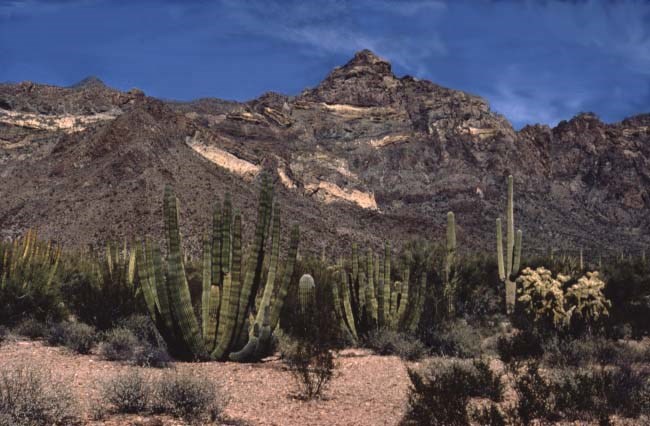
Trump’s Border Wall Desecrates the Sacred

Organ Pipe Cactus Landscape – NPS Photo
Opinion
Published February 17, 2020
During the 2016 Dakota Access Pipeline protests, the Standing Rock Sioux Tribe community and many other American Indians from around the nation fought vehemently against the proposed pipeline’s route under freshwater rivers and lakes, as well as its intended route through Standing Rock’s ancestral tribal lands.
Over the course of almost a year, the Standing Rock resistance became the largest gathering in modern American Indian history.
Knowing oil pipelines have leaks, Standing Rock tribal officials and citizens feared—and still do fear—a leak will occur into the Missouri River, creating a horrific impact of contaminated drinking water for 18 million people downstream.
The Standing Rock’s mantra became “Mni-Wiconi,” meaning Water is Life.
Beyond the concern of potential leakages to protect water, tribal officials were angry because certain parts of the pipeline’s route would go through ancestral burial sites. Just as any civilized society would not allow for cemeteries to be dug up during construction for development, Standing Rock tribal citizens did not want their ancestors’ graves disturbed and destroyed forever.
In August 2016, I interviewed Phyliss Young, a former Standing Rock Tribe tribal council member, who explained tribal officials knew locations of several ancestral graves near the confluence of the Missouri and Cannonball Rivers — graves that tribal citizens still visited.
Young told me these graves’ locations would not show up on any map and were never written down because of the history of non-Native people digging up and desecrating Indigenous ancestral graves. Grave robbing American Indian burial grounds has long been a practice in American history for hobby or archeological research.
In the case of Standing Rock, the desecration of Indigenous ancestral graves was to satisfy the greed of a Canadian oil company that wanted to take oil down to the Gulf of Mexico to export it to Asia.
Young further explained the federal government never allowed for meaningful tribal consultation that should have been afforded through a government-to-government agreement between the United States and sovereign tribal nations—in this case, the Standing Rock Tribe.
Fast-forward to 2020. The desecration of Indigenous tribal ancestral graves continues at the southern border of the United States. This time, the desecration is happening along the route of the southern border wall President Trump promised to build during his 2016 presidential campaign.
This time, the desecration involves another American Indian tribe, the Tohono O’odham Nation.
This time, the desecration is happening (again) without meaningful tribal consultation.
In recent weeks, construction crews contracted by the U.S. Customs and Border Protection agency (CBP) have been blasting through the Roosevelt easement in southern Arizona that includes the Organ Pipe Cactus National Monument, which is part of the traditional homelands of the Tohono O’odham Nation. Not only is the monument sacred to the Tohono O’odham Nation, but the area has been designated as a biosphere reserve by the United Nations because it is full of rare plants and animals.
Last week in Washington D.C., Tohono O’odham Nation Chairman Ned Norris Jr. rose to his feet during the question-and-answer period after Assistant Secretary of the Interior for Indian Affairs Tara Sweeney finished her update to the National Congress of the American Indians to let her know is displeasure for the federal government’s desecration of sacred sites at the monument.
“They desecrated those human remains that were there,” Chairman Norris said. “You have an obligation to protect sacred sites and sacred areas and religious areas for Native American people. You have failed to make sure…I call on you to exercise your responsibility and stop the destruction of sacred sites of Native American communities.”
The blasting quickly drew the attention of U.S. Rep. Raúl M. Grijalva (D-Ariz.), whose district includes the monument. On January 7, 2020, he sent a letter expressing his concern about the lack of tribal consultation with the Tohono O’odham Nation.
In 2020, the lack of tribal consultation is nothing short of astounding. The current case involves the Customs and Border Protection agency, which operates under the federal Dept. of Homeland Security. DHS has a tribal consultation policy that reads in part:
The Department of Homeland Security (DHS) is committed to strengthening the government-to-government relationship between the United States and Indian Tribes. DHS recognizes that agency policies, programs, and services may directly or indirectly impact Indian Tribes and is committed to regularly and meaningfully collaborating, communicating, and cooperating with Indian Tribes with regard to policies that have Tribal Implications.
Levi Rickert
The CBP maintains they conducted tests along the route where the blasting took place and found no evidence of burial sites. While their tests may have come back negative, they would have heard a different story from the Tohono O’odham Nation, which knows the location of the sites.
Similar to the Standing Rock Sioux Tribe that was not apt to publicize the exact locations of the sacred sites, the Tohono O’odham Nation did not publicize where their burial sites are located. CPB would have learned this if they had done some meaningful collaboration, communication and cooperation with the tribe.
One can argue the merits of Trump’s border wall, but that’s largely a partisan argument. One would hope though, that even in a nation as divided as ours right now, we should all be able to acknowledge that honoring the graves of the deceased is the right thing to do.
Levi Rickert (Prairie Band Potawatomi Nation) is the publisher and editor of Native News Online. @LeviRickert1
The post Trump’s Border Wall Desecrates the Sacred appeared first on Native News Online.
